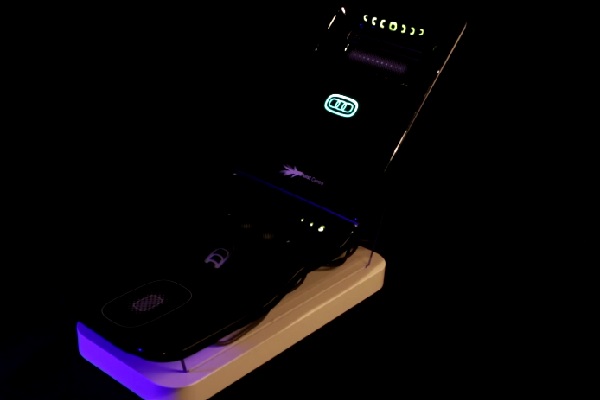A functional demonstrator using Holst Centre’s in-mold electronics (IME) technology points to a bright future for intuitive human-machine interfaces (HMIs) in automotive electronics and consumer appliances. Developed by a group of key industry players led by Holst Centre, the demonstrator, a car center console, features a mobile phone storage space with integrated NFC connectivity and touch controls illuminated by flexible OLEDs. Light and conformal, IME technology integrates all this functionality directly into a 3D plastic surface just 1.5 mm thick. The demonstrator shows how IME technology could be applied in anything from shavers to car cockpits.
The console demonstrator highlights IME’s potential for transforming ‘dumb’ plastic structures with embedded intelligence to enable enhanced and intuitive user experiences. All the electronics are fabricated on a stretchable, flexible and formable smart skin that is then integrated into the plastic during standard thermoforming or injection molding processes. The technique can be used to create 3D smart objects or extremely thin functional surfaces of any form.
“This is the first time a flexible OLED has been used to illuminate touch controls. Such effects typically require several LEDs, light guides, bulky PCBs and a lot of separate wiring. Through OLEDs and printed electronics, our smart skin approach lets manufacturers of plastic objects add intelligence and functionality much more easily and with complete design freedom. This enables simpler build-up of plastic products that are visually stunning. It also dramatically reduces the weight and size of functional plastic products, which could be interesting in the automotive world for fuel economy,” says Jeroen van den Brand, Program Director for hybrid and printed electronics at Holst Centre.
The demonstrator and the smart skin technology it employs were developed within Holst Centre’s IME shared research program. This is a complete, end-to-end innovation ecosystem of partners covering stages in the value chain: from materials suppliers like DuPont (who provide the key enabling thermoformable electronic inks and pastes) to potential end-users such as Faurecia (the world’s leading supplier of automotive interiors).
The console was exhibited at Nano Tech 2017 in Tokyo, Japan in mid-February. It will also be on display on our booth
B0/204 at the LOPEC Conference in Munich, Germany, taking place March 28 – 30.



















